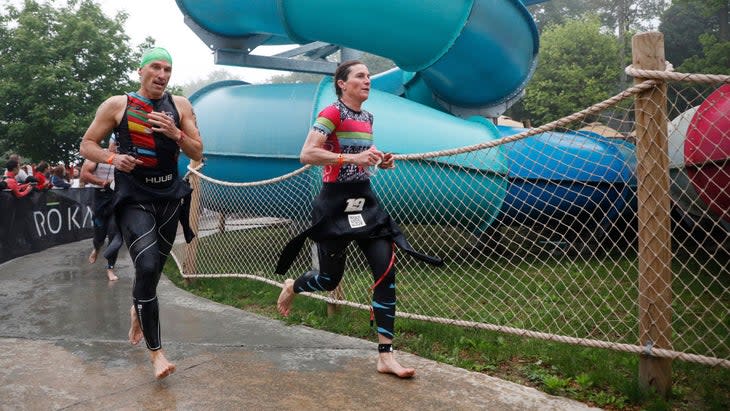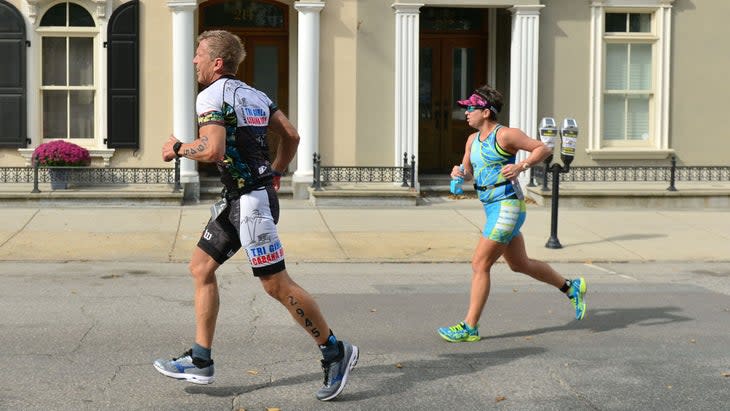What Do I Wear to My First Triathlon?
This article originally appeared on Triathlete
Of all the questions new triathletes have, perhaps the one we hear the most is "What do I wear to my first triathlon?" It's understandable so many have questions about clothing--after all, a running race, like a 5K, has a pretty straightforward wardrobe. So does a cycling race or a swim race, for that matter. But when you put all three sports together, does that mean you have to change your clothes each time you change disciplines? How do you pull off something that has more costume changes than a Lady Gaga concert?
Let's talk about what to wear during a triathlon, when you will (and won't) have to change your clothes, and how to pull it all together on race day.
Do you have more questions about your first (second, third, or tenth) tri? We have an active and supportive community of everyday athletes and experts in Team Triathlete who are willing to help. Plus: Members have exclusive, near-instant access to the entire editorial staff at Triathlete. Help is just an @ away! Become an Outside+ Member and join Team Triathlete now!
What do I wear to my first triathlon?
When you train, you probably wear a swimsuit in the pool, a pair of cycling shorts on the bike, and a tech tee and shorts on the run. Those three different outfits each serve to keep you comfortable for the specific demands of their respective sport.
When you race your first triathlon, however, you'll ideally want to wear the same clothing from start to finish. The best triathlon clothing takes the features from each of the above outfits to create what's known as a "tri suit," which is optimized for triathlon performance. The features of the tri suit include:
Sleek, hydrodynamic fabric (like that of a swimsuit), which lets you glide through the water with ease. If you wear a wetsuit over your kit in your swim, this fabric slips under your wetsuit without added bulk.
Padding in the crotch of the shorts to keep your undercarriage comfortable while you ride. Unlike standard bike shorts, which have thick padding, a triathlon pad, or "chamois," is thinner to give you protection on the bike without added bulk. Why is this important? Because after you get off the bike, you've got to run--and no one likes running in something that feels like a diaper.
Quick-drying properties to aid in drying off after the swim and while you sweat during the bike or run.
Pockets--lots of 'em. You're doing three sports, after all; that requires you to carry a few items, like nutrition or hydration.
Strategically-designed seams (or a lack thereof) to prevent blisters and chafing during repetitive movements.
RELATED: The Best Race Kits for Triathlon
When you wear a tri suit in your first triathlon, you'll wear it for the duration of a race. The only thing that changes are the accessories. After the swim, as you transition to the bike (also known as "T1"), you'll take off your goggles, swim cap, and wetsuit (if you chose to wear one). You'll put on your cycling shoes, helmet, and sunglasses. When you're done with the bike, you'll transition to the run (or "T2") by taking off your cycling gear and putting on your running shoes and socks (if you choose to wear socks; some people go without to save time).
RELATED: Doing Your First Triathlon This Year? How to Handle Transitions Like a Pro

Can I change my clothes during a triathlon?
The logic of wearing the same outfit for the duration of your triathlon is not just about expediency, but logistics. For sprint, Olympic, and half-iron/70.3 races, you probably won't have a place to change your clothes. Moving from swim to bike to run happens openly in the transition area, with each athlete changing their accessories in a designated spot next to their bike. If you insist on changing your clothes during one of these races, remember that nudity is generally frowned upon (if not outright illegal), so you'll probably have to change clothes in the port-a-potty, which is bound to be a cramped (and stinky) endeavor.
The exception to the no-changing setup? Ironman and its iron-distance ilk. These day-long races usually offer athletes the opportunity to change their clothes in private tents if they wish (many don't, choosing to stay in the same clothes from start to finish). The longer the race, the more potential for discomfort and chafing, so some athletes choose to start out in a swimsuit so they can head out on the bike leg in dry clothes, or swap out their cycling chamois for a pair of running shorts. For these athletes, the physical or mental boost from a fresh and dry outfit is worth the added time.
For more on wardrobe changes during an Ironman, visit Your Triathlon Change Tent Questions, Answered.
Do I have to buy a tri suit for my first triathlon?
Not necessarily! In fact, for your first triathlon, it's fine if you want to wear what you already have on hand for training. Some choose to do the entirety of the race in their swimsuits (even some professional triathletes do this!). Others mix-and-match items like bike shorts and running tank tops. And some choose to invest in just one piece, like tri shorts (or the bottom half of a tri suit) and wear it with items they already own.
RELATED: We Gave a Total Newbie $600 (and Six Weeks) for His First Triathlon
All of these are solid strategies for saving money on triathlon clothes, especially when you're new to the sport. But one word of warning: make sure to test your clothes in training! Your cycling shorts may be super-comfy on a training ride, but what happens when you wear them in the pool first? The thick pad may create drag during the swim, become waterlogged and squishy when riding, or chafe during the run. Don't let race day be the time you discover this. Train for all three sports while wearing the clothes you plan to race in, so you can address issues well in advance.

Why are triathlon clothes so tight?
When trying on triathlon clothes, you want them to feel like a second skin: compressive, but not overly tight. Your breathing should not be restricted, and there should be no loose fabric.
It may sound counterintuitive at first, but a form-fitting tri kit is more comfortable to race in. A baggy top will balloon up or scoop water during the swim, making things harder on you as you try to make your way through the water; ditto for the bike, when you want to slice through the air without your clothes creating a parachute. Loose clothes also have more leeway to rub against the skin, which can cause blisters and chafing as you run.
If you're feeling self-conscious about wearing a skin-tight garment during your race, remember that we're all out there in the exact same clothes. Besides, you look strong, because you are!
Should I wear underwear under my triathlon clothes?
If you have breasts, you'll likely want to wear a sports bra. Some triathlon suits for women have built-in sports bras, but unless you are extremely small-chested, you'll probably prefer wearing something additional with more support, especially during the run. Just like choosing a tri suit, you'll want to select something that fits well, doesn't chafe, and has minimal padding (otherwise, you'll be carrying around a lot of water after the swim).
RELATED: Ask a Gear Guru: What Are the Best Sports Bras Right Now?
What about down below? Should you wear underwear under your bike shorts or tri suit? It's really, really, really not recommended. For starters, your tri suit and shorts are made of fabric designed to wick sweat away from the body; wearing another layer of fabric between your skin and your tri suit can interfere with that process. The moisture retained by your underwear, along with any present seams, can up the potential for chafing, ingrown hairs, and saddle sores (painful skin lesions that form after friction on the genitals or thighs). It's best to go commando under your tri suit. It may feel weird at first, but it will soon become second nature.
What do I wear to my first triathlon? Tips and tricks
Always check the rules of your race. Though most follow national federation rules (like USA Triathlon's) for clothing and gear, there is some variation in the way these rules are enforced. For example, some races allow athletes to run shirtless (or in a sports bra only) while others require the torso to be covered. Ditto for logos or slogans that may be considered profane or offensive.
Practice your transitions. In addition to helping you shave seconds off your overall time on race day, transition practice can help you figure out what does (and doesn't work) for you as far as clothing and gear.
Consider what you will need to stay comfortable for the duration of your race, and complement your tri suit accordingly beyond the basics. This may mean adding UPF compression sleeves to protect your arms and shoulders from the sun or elastic laces in your running shoes for faster transitions.
Have a hat emblazoned with the logo of your tri club, or a tank top that declares you beat cancer? Wear it! In addition to showing off your personality, wearing something you love can boost your confidence. Even superheroes accessorize their spandex suits with a cape.
Remember: There is no standard uniform! When choosing what to wear for your first triathlon, choose what will make you most comfortable.
RELATED: Tri 101: How to Get Started in Triathlon
For exclusive access to all of our fitness, gear, adventure, and travel stories, plus discounts on trips, events, and gear, sign up for Outside+ today.

